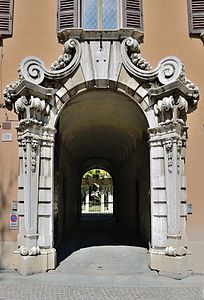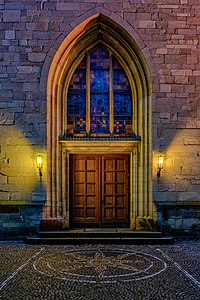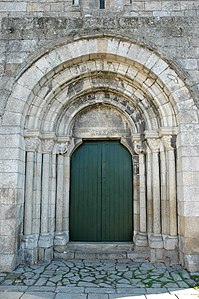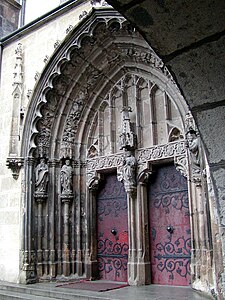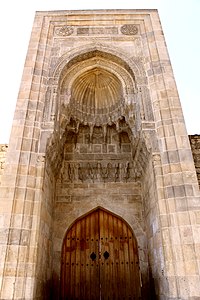This article relies largely or entirely on a
single source. (June 2018) |

A portal is an opening in a wall of a building, gate or fortification, especially a grand entrance to an important structure. [1][ page needed]
Doors, metal gates, or portcullis in the opening can be used to control entry or exit. The surface surrounding the opening may be made of simple building materials or decorated with ornamentation. The elements of a portal can include the voussoir, tympanum, an ornamented mullion or trumeau between doors, and columns with carvings of saints in the westwork of a church.[ citation needed]
Examples
-
Baroque portal of a private palace in Brescia
-
Wooden portal of the Church of St. Victor in Dülmen
-
Romanesque portal of the Church of São Martinho de Cedofeita, with nested arches
-
Gothic portal of the church in Hronský Beňadik
-
Romantic portal of the St. John's Cathedral in Tampere
-
Gothic portal of the Cathedral of Saint Stephen in Metz
-
Taşkapı (stone gatehouse) of the Hatuniye Medresesi in Karaman
Other uses
The term portal is also applied to the ends of a tunnel.[ citation needed]
See also
References
- ^ Ching, Francis (1997). A Visual Dictionary of Architecture. New York: Van Nostrand Reinhold. ISBN 0-442-02462-2.
This article relies largely or entirely on a
single source. (June 2018) |

A portal is an opening in a wall of a building, gate or fortification, especially a grand entrance to an important structure. [1][ page needed]
Doors, metal gates, or portcullis in the opening can be used to control entry or exit. The surface surrounding the opening may be made of simple building materials or decorated with ornamentation. The elements of a portal can include the voussoir, tympanum, an ornamented mullion or trumeau between doors, and columns with carvings of saints in the westwork of a church.[ citation needed]
Examples
-
Baroque portal of a private palace in Brescia
-
Wooden portal of the Church of St. Victor in Dülmen
-
Romanesque portal of the Church of São Martinho de Cedofeita, with nested arches
-
Gothic portal of the church in Hronský Beňadik
-
Romantic portal of the St. John's Cathedral in Tampere
-
Gothic portal of the Cathedral of Saint Stephen in Metz
-
Taşkapı (stone gatehouse) of the Hatuniye Medresesi in Karaman
Other uses
The term portal is also applied to the ends of a tunnel.[ citation needed]
See also
References
- ^ Ching, Francis (1997). A Visual Dictionary of Architecture. New York: Van Nostrand Reinhold. ISBN 0-442-02462-2.
